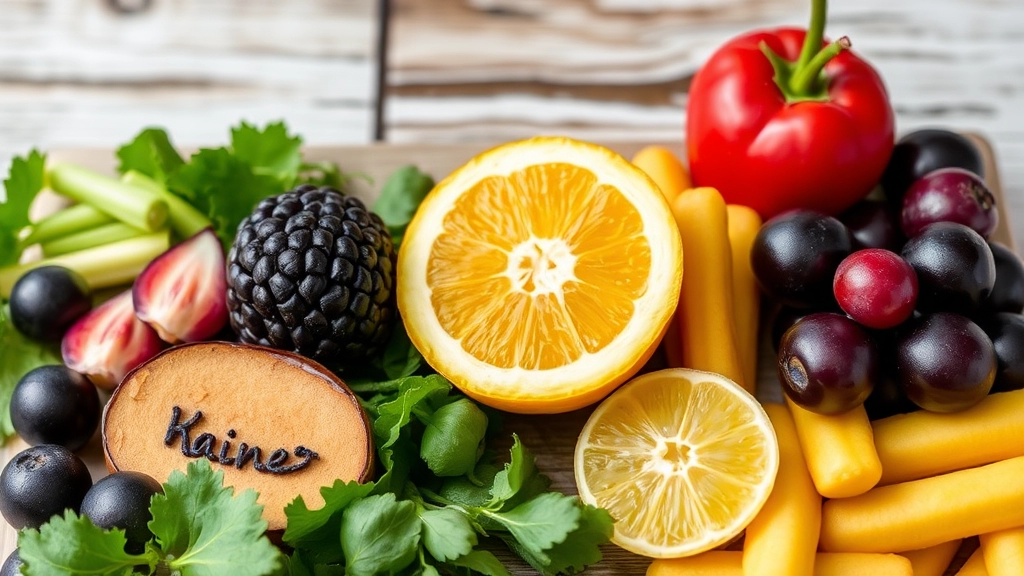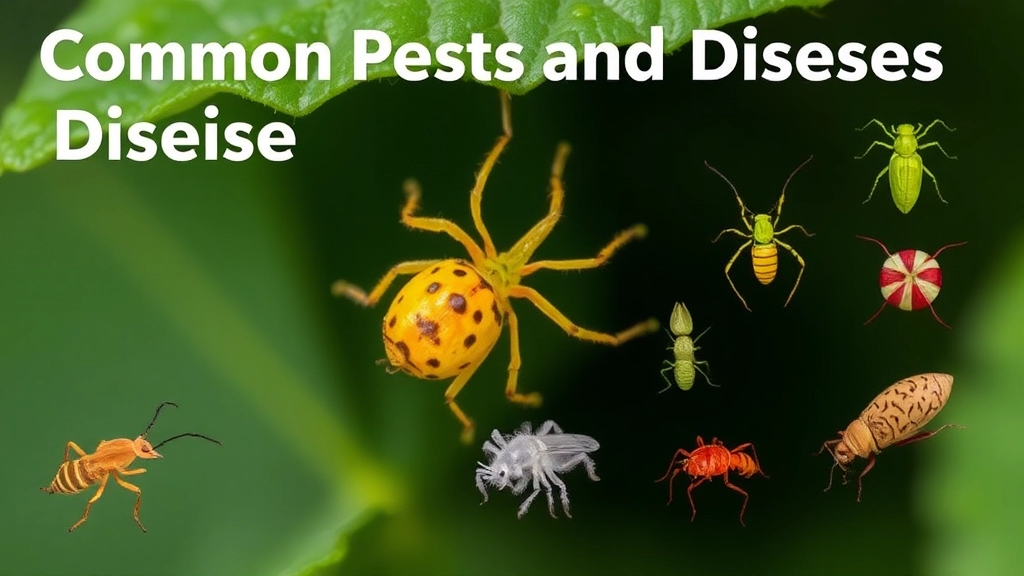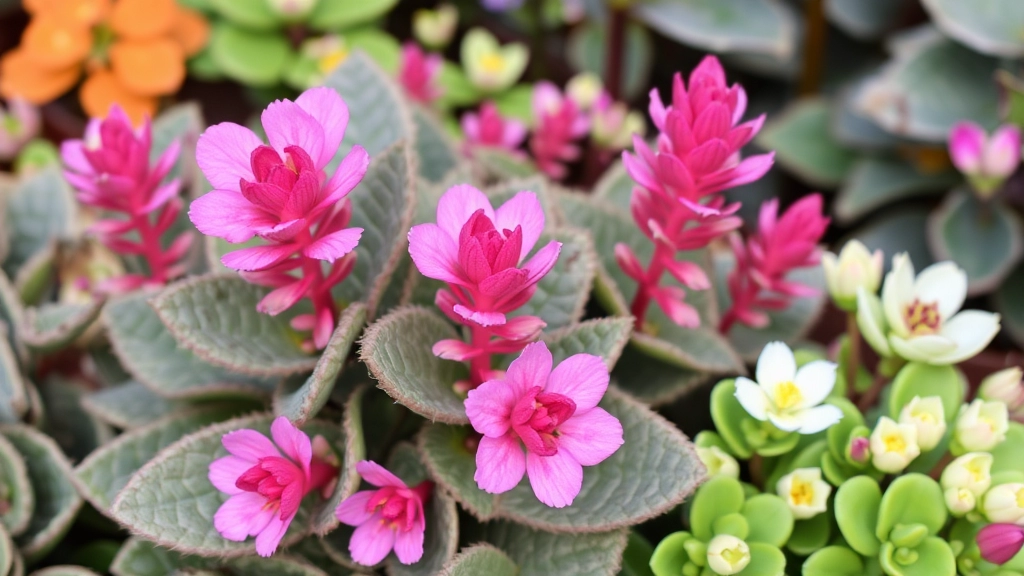Welcome to the fuzzy, fabulous world of kalanchoe tomentosa varieties!
As a plant enthusiast, I’m thrilled to take you on a journey through the diverse and delightful members of this succulent family. From the classic Panda Plant to the elegant ‘Black Tie’, we’ll explore the unique characteristics that make each variety a standout in any plant collection.
In this article, we’ll dive into the popular varieties, their distinct features, and essential care tips to help your kalanchoe tomentosa thrive. Whether you’re a seasoned plant parent or a curious newcomer, you’ll discover why these velvety succulents have captured the hearts of plant lovers worldwide. Get ready to fall in love with these charming, low-maintenance beauties!
Popular Varieties of Kalanchoe Tomentosa
Let’s dive into the world of Kalanchoe tomentosa, shall we?
These fuzzy little succulents are absolute gems in any plant collection.
But did you know there’s more than one type?
Oh yeah, we’re not just talking about your standard Panda Plant here.
There’s a whole family of these furry fellas waiting to be discovered.
First up, we’ve got the classic Kalanchoe tomentosa ‘Chocolate Soldier’.
This bad boy’s got leaves that look like they’ve been dipped in cocoa.
Seriously, it’s like nature’s version of a chocolate-covered strawberry.
Then there’s the ‘Golden Girl’ variety.
Picture this: leaves that shimmer with a golden hue under the sun.
It’s like your plant’s throwing its own disco party.
Don’t forget about the ‘Black Tie’ variety.
This one’s for all you fancy pants out there.
Dark, almost black leaves with a silver fuzz? Talk about plant elegance.
And let’s not overlook the ‘Cinnamon’ variety.
Yep, you guessed it – leaves that look like they’ve been dusted with cinnamon.
Makes your plant shelf smell great? Sadly, no. But it sure looks tasty.
These are just a few of the Kalanchoe tomentosa varieties out there.
Each one’s got its own unique charm, ready to jazz up your space.
So, which Kalanchoe tomentosa variety are you eyeing up?
Unique Features of Each Variety

Alright, let’s dive into the unique features of each Kalanchoe tomentosa variety. Trust me, these fuzzy little succulents are more diverse than you might think!
When I first got into Kalanchoe tomentosa, I thought they were all the same. Boy, was I wrong! Each variety has its own quirks and charms that make it stand out. Let’s break it down:
1. Chocolate Soldier
- Leaves: Dark green with brown edges
- Texture: Super fuzzy, like a teddy bear
- Size: Compact, perfect for small spaces
This one’s my personal favourite. It’s like having a tiny, chocolatey forest on your windowsill.
2. Golden Girl
- Colour: Bright green leaves with golden tips
- Growth: Faster than other varieties
- Flowers: Produces more blooms
If you’re after a showstopper, Golden Girl’s your gal. She’s a real attention-grabber.
3. Black Tie
- Appearance: Deep, almost black leaves
- Contrast: Silver fuzz creates a striking look
- Care: Needs less water than other varieties
Black Tie’s the cool kid of the Kalanchoe world. It’s like the James Bond of succulents.
4. Panda Plant
- Pattern: Silver-grey leaves with brown spots
- Shape: Triangular leaves, different from others
- Texture: Extra furry, seriously irresistible to touch
Ever wanted to pet a plant? Panda Plant’s your chance. It’s like a cuddly, living stuffed animal.
5. Teddy Bear
- Size: Smaller leaves than other varieties
- Colour: Pale green with reddish-brown edges
- Growth: Forms dense clusters
This little guy’s a real crowd-pleaser. It’s compact, cute, and hard not to love.
Each of these Kalanchoe tomentosa varieties brings something unique to the table. Whether you’re after colour, texture, or growth habit, there’s a fuzzy friend for everyone. And let’s be honest, who doesn’t want a plant that looks like it needs a good cuddle?
Remember, the key to happy Kalanchoes is understanding their individual quirks. Treat each variety like the unique little character it is, and you’ll have a thriving, fuzzy family in no time.
So, which Kalanchoe tomentosa variety caught your eye? Trust me, once you start collecting these fuzzy fellas, it’s hard to stop! If you’re interested in other Kalanchoe species, you might want to check out the flowering period of Kalanchoe blossfeldiana or learn about the medicinal uses of Kalanchoe pinnata.
Growing Conditions for Kalanchoe Tomentosa Varieties
Alright, let’s dive into the growing conditions for Kalanchoe tomentosa varieties.
These fuzzy succulents are pretty chill, but they do have some preferences.
Light
- They’re sun-lovers, but not scorching heat fans.
- Bright, indirect light is their sweet spot.
- A few hours of morning sun? Perfect.
- Afternoon rays? Might be a bit much.
Temperature
- Think warm, but not tropical.
- 15-24°C (59-75°F) is their happy zone.
- They can handle a bit cooler, but frost? Absolute no-go.
Soil
- Well-draining is the name of the game.
- Cactus mix with some extra perlite? Spot on.
- Soggy soil is their nemesis, so keep it loose and airy.
Humidity
- These guys aren’t fussy about humidity.
- Average room humidity works just fine.
- No need for misting or humidifiers here.
Container
- Pots with drainage holes are a must.
- Terracotta’s great – it helps excess moisture evaporate.
- Size-wise, don’t go too big. They like to be a bit snug.
Feeding
- Light feeders, these Kalanchoes.
- A diluted succulent fertiliser once a month during growing season? Plenty.
- Winter? Give them a break from the food.
Remember, Kalanchoe tomentosa varieties are pretty forgiving.
Get these basics right, and they’ll thrive with minimal fuss.
It’s all about mimicking their natural habitat – sunny, warm, and on the dry side.
Watering and Maintenance Tips
Alright, let’s dive into the nitty-gritty of keeping your Kalanchoe tomentosa happy and thriving. Trust me, I’ve learned these tips the hard way, so you don’t have to!
Watering: The Golden Rule
First things first, Kalanchoe tomentosa is a succulent, which means it’s a pro at storing water. The golden rule? Less is more. Here’s how I approach it:
- Water deeply but infrequently
- Allow the soil to dry out completely between waterings
- In winter, cut back on watering even more
Pro tip: If you’re unsure, it’s better to underwater than overwater. These fuzzy little guys are more forgiving of drought than drowning.
Soil and Drainage: The Foundation of Success
You know what Kalanchoe tomentosa absolutely hates? Wet feet. Here’s how to keep them happy:
- Use a well-draining potting mix (I mix regular potting soil with perlite or sand)
- Ensure your pot has drainage holes
- Consider using terracotta pots – they help wick away excess moisture
Light and Temperature: Finding the Sweet Spot
These succulents love light, but they’re not fans of scorching sun. Here’s what works for me:
- Bright, indirect light is ideal
- Morning sun is great, afternoon sun can be too harsh
- They prefer temperatures between 60-75°F (15-24°C)
Fertilising: A Little Goes a Long Way
Kalanchoe tomentosa isn’t a heavy feeder, but a little boost now and then doesn’t hurt. I stick to this simple routine:
- Fertilise once a month during the growing season (spring and summer)
- Use a balanced, water-soluble fertiliser diluted to half strength
- Skip fertilising in autumn and winter
Pruning and Grooming: Keeping It Tidy
While these plants are low-maintenance, a bit of grooming goes a long way:
- Remove dead or yellowing leaves regularly
- Trim leggy growth to encourage bushiness
- If flowering, remove spent blooms to promote more flowers
Remember, the key to maintaining Kalanchoe tomentosa is to mimic its natural desert habitat. It’s all about finding that balance between neglect and care. Trust me, once you get the hang of it, you’ll be amazed at how easy these fuzzy friends are to keep happy! If you’re interested in other Kalanchoe varieties, check out the Kalanchoe blossfeldiana succulent for a colorful alternative. For those curious about the medicinal properties of Kalanchoe species, the medicinal Kalanchoe pinnata is worth exploring.
Propagation Methods for Different Varieties
Let’s chat about how to make more of these fuzzy beauties, shall we?
Kalanchoe tomentosa varieties are pretty chill when it comes to propagation.
Here’s the lowdown on getting more of these cuties:
Leaf Propagation:
- Snip a healthy leaf
- Let it dry for a day or two
- Pop it on some well-draining soil
- Mist occasionally
- Watch for tiny plantlets in a few weeks
Stem Cuttings:
- Cut a 3-4 inch stem
- Remove lower leaves
- Let it callous over for a day
- Stick it in soil or water
- Keep it warm and bright
Division:
- Gently separate offsets from the mother plant
- Ensure each piece has roots
- Replant in fresh soil
Pro tip: Spring and summer are prime time for propagation.
Different varieties might have their quirks, but these methods work for most.
The ‘Chocolate Soldier’ and ‘Golden Girl’ are especially easy to propagate from leaves.
Remember, patience is key. These little guys take their sweet time to root.
But trust me, the wait is worth it when you see those baby plants popping up.
So, ready to multiply your Kalanchoe collection? Give it a go!
Common Pests and Diseases

Let’s chat about the not-so-fun part of growing Kalanchoe tomentosa – the pesky critters and nasty diseases that can mess with your plants. Trust me, I’ve been there, and it’s no picnic. But don’t worry, I’ve got your back!
Creepy Crawlies to Watch Out For
- Mealybugs: These little cotton-ball lookalikes love to suck the life out of your plants. Sneaky buggers!
- Spider mites: Tiny but mighty, they’ll leave your leaves looking speckled and sad.
- Aphids: Green, black, or brown, these sap-suckers can multiply faster than you can say “Kalanchoe”.
Nasty Diseases That Might Pop Up
- Root rot: Too much water? Your roots might turn to mush. Yuck!
- Powdery mildew: Looks like someone dusted your plant with flour. Not cool.
- Leaf spot: Brown or black spots on leaves? Could be fungal trouble.
How to Keep Your Kalanchoe Happy and Healthy
- Keep it clean: Wipe those leaves down regularly. It’s like a spa day for your plant!
- Don’t overwater: Seriously, these guys hate wet feet.
- Good air flow: Let that breeze tickle your plant’s leaves.
- Quarantine new plants: New addition? Keep it separate for a bit, just in case.
If Trouble Strikes
- Neem oil: Nature’s pest control, and it smells nice too!
- Pruning: Sometimes you gotta cut your losses (literally).
- Repotting: Fresh soil can work wonders.
Remember, prevention is better than cure. Keep an eye on your Kalanchoe tomentosa, and you’ll catch problems before they get out of hand. Trust me, your plant will thank you! If you’re looking for more specific care tips, check out our guide on choosing the right soil for Kalanchoe blossfeldiana. And for those interested in the medicinal properties of Kalanchoe, our article on Kalanchoe pinnata’s medicinal uses is a must-read!
Benefits of Growing Kalanchoe Tomentosa
Let’s chat about why Kalanchoe tomentosa is such a cool plant to have around.
First off, it’s a total eye-catcher.
Those fuzzy leaves? They’re like velvet to touch.
And the colours? From silvery-green to deep chocolate, they’re stunning.
But it’s not just about looks.
These plants are tough as nails.
Forget to water for a bit? No worries, they can handle it.
Perfect for busy folks or those of us who aren’t exactly plant whisperers.
They’re also air purifiers, helping to keep your space fresh.
And let’s talk stress relief.
There’s something calming about caring for a plant, especially one this low-maintenance.
Got allergies? Kalanchoe tomentosa is your new best mate.
It’s hypoallergenic, so no sneezing fits here.
Plus, they’re compact.
Great for small spaces or as desk buddies at work.
And if you’re into propagation, these plants are a dream.
Easy to grow new ones from cuttings.
Free plants, anyone?
Lastly, they’re non-toxic to pets.
So your furry friends can coexist safely with your green pals.
In short, Kalanchoe tomentosa brings beauty, ease, and a touch of nature to your life.
What’s not to love about that?
Creative Ways to Display Kalanchoe Tomentosa Varieties
Alright, let’s talk about jazzing up your space with these fuzzy little succulents. Kalanchoe tomentosa, or panda plant as some folks call it, isn’t just another pretty face in your plant collection. It’s a versatile little bugger that can really spice up your decor game. Here’s how I like to show ’em off:
1. Funky Hanging Planters
Ever thought about dangling these bad boys from the ceiling? Grab some macramé hangers or those trendy geometric wire planters, and boom! You’ve got yourself an eye-catching display that doesn’t eat up precious shelf space.
2. Succulent Wall Art
Who says art has to be flat? Create a living wall with different Kalanchoe tomentosa varieties. Mix and match colours and textures for a 3D masterpiece that’ll have your mates green with envy.
3. Terrarium Takeover
Chuck a few panda plants in a glass container with some pebbles and sand. Instant mini desert vibes, no watering can required.
4. Windowsill Wonders
Line up a few different varieties on your sunniest windowsill. It’s like a fuzzy, green rainbow that’ll perk up even the dreariest day.
5. Desk Buddy
Plop a small Kalanchoe in a quirky container on your work desk. It’s low-maintenance enough to survive your forgetfulness and cute enough to make spreadsheets slightly less soul-crushing.
6. Bathroom Beauties
These tough little plants can handle humidity like champs. Pop one on your bathroom counter for a spa-like feel without the spa-like price tag.
7. Outdoor Oasis
Got a sunny spot on your balcony or patio? Group a few Kalanchoe varieties in weatherproof pots for a low-effort, high-impact outdoor display.
Remember, the key to nailing these displays is to have fun with it. Mix up pot sizes, play with heights, and don’t be afraid to get a bit quirky. After all, these fuzzy little suckers are anything but boring, so why should your displays be?
And hey, if all else fails, just stick ’em wherever you’ve got space. These resilient little troopers will thrive pretty much anywhere you plonk them down. That’s the beauty of Kalanchoe tomentosa varieties – they’re as easy-going as they are eye-catching.
FAQs about Kalanchoe Tomentosa Varieties
Q: How many varieties of Kalanchoe tomentosa are there?
A: While there are several varieties, some of the most popular include ‘Chocolate Soldier’, ‘Golden Girl’, ‘Black Tie’, ‘Panda Plant’, and ‘Teddy Bear’. Each has unique characteristics in terms of color, leaf shape, and growth habits.
Q: Are Kalanchoe tomentosa varieties difficult to care for?
A: Not at all! These succulents are known for being low-maintenance. They prefer bright, indirect light, well-draining soil, and infrequent watering. They’re quite forgiving, making them great for beginners or busy plant owners.
Q: Can I grow Kalanchoe tomentosa outdoors?
A: Yes, you can grow them outdoors in suitable climates. They thrive in USDA zones 9-11. However, they can’t tolerate frost, so in colder regions, it’s best to keep them as indoor plants or move them indoors during winter.
Q: How often should I water my Kalanchoe tomentosa?
A: These plants prefer to dry out between waterings. In general, watering once every 2-3 weeks is sufficient. Always check the soil moisture before watering and reduce frequency in winter.
Q: Are Kalanchoe tomentosa varieties toxic to pets?
A: Unlike some other Kalanchoe species, Kalanchoe tomentosa is generally considered non-toxic to pets. However, it’s always best to keep plants out of reach of curious pets to prevent any digestive upset.
Q: How can I propagate my Kalanchoe tomentosa?
A: These plants are easy to propagate! You can use leaf cuttings, stem cuttings, or division. Simply allow the cuttings to callous over for a day or two, then plant in well-draining soil.
Q: Why are the leaves on my Kalanchoe tomentosa falling off?
A: Leaf drop can be caused by overwatering, underwatering, or sudden temperature changes. Check your watering habits and ensure the plant isn’t in a drafty area or exposed to extreme temperatures.
Q: Do Kalanchoe tomentosa varieties flower?
A: Yes, they can flower, but it’s relatively rare in indoor conditions. When they do bloom, they produce small, tubular flowers in clusters.
References
-
Kalanchoe tomentosa Care Guide Comprehensive guide to Kalanchoe tomentosa care and varieties
-
Common Succulent Pests and Diseases Information on pests and diseases affecting succulents, including Kalanchoe

